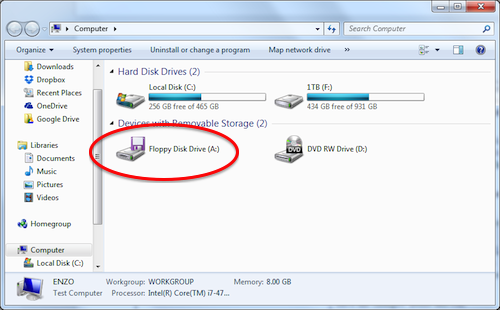The year is 1992 — some 22 years ago. PCs For Dummies was my second book in the For Dummies series, co-authored with Andy Rathbone (who went on to write Windows For Dummies and, soon after, retire).
One whole chapter in that book was devoted to a topic that doesn’t even resonate today: Formatting a floppy disk.
Here are some quotes from that book, which believe-it-or-not is still “in print.” So I’m risking the wrath of my publisher’s attorneys, but I’m just that type of person.
If you want to format the disk in your A drive, type the following command:
C:\>FORMAT A:That’s the word FORMAT, followed by a space, then the letter A (for the A: drive) immediately followed by a colon.
Computers no longer use floppies for storage. The reason is that the commonly available, highest-capacity floppy disk held about 1.4 megabytes. That’s nothing today. Further, the disks were unreliable and bulky.
Drive A is still around; it’s registered by Windows internally as the first floppy drive. (B is the second drive.) Believe it or not, if you attach a USB floppy drive to your PC, it appears as Drive A, as shown in Figure 1.

Figure 1. A USB floppy drive is connected to my PC.
PCs For Dummies 1st Edition came out three years before Windows 95. DOS was the king. People typed commands. Computers weren’t sold with a mouse. So here continues my book’s directions on how to wade through the formatting process:
The computer responds by asking you to insert a diskette in drive A: and press the Enter key; put the disk in the drive if you haven’t already.
For a 5 1/4-inch disk drive, close the drive’s door latch after inserting the disk. Then press the Enter key.
Yeah, you had to manually close the drive door on a 5 1/4-inch diskette.
The formatting process will take a minute or two, so pick at the spots on your desk for a while.
Also — and this is bad — you could do nothing else with your PC while you formatted a disk. DOS didn’t multi-task. Even Windows back in the day wouldn’t let you do anything else with your computer while you formatted a floppy. (The DESQview environment would let you format and do other things; it was a multitasking shell available for DOS.)
When formatting is done, you’ll be asked two questions: The first is to enter a volume label. Here you can press Enter for “no volume label.” If you like, you can type something descriptive about the disk, but you’re only limited to 12 characters so, what the heck, just press Enter.
The second question you’re asked is if you want to “Format another?” Press N. You can
now use the disk.
Every dang doodle disk you used had to be formatted first. Only later, say in the late 1990s, did floppy disks come pre-formatted.
Today, of course, nothing needs to be formatted. Even if you purchase an external hard drive, it comes pre-formatted and your computer instantly recognizes and uses that format.
Still, the Format command lingers in Windows. You can right-click on any disk in the My Computer window on a PC and choose to Format storage media. You don’t need to, and I don’t recommend doing so unless something is wrong, but the Format command sticks around as a relic of days gone by.

